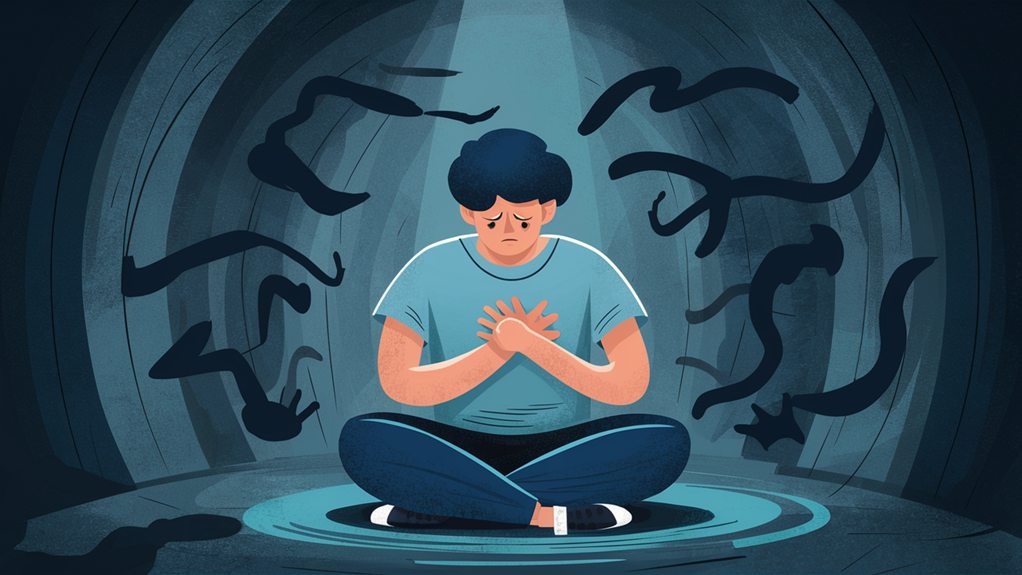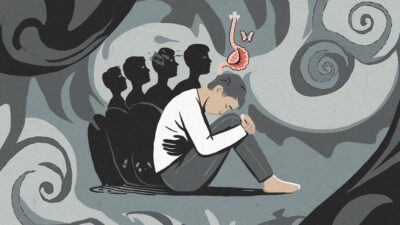Anxiety is more than just feeling worried or stressed – it's a real mental health condition that can greatly impact your daily life. You might experience physical symptoms like a racing heart and sweaty palms, along with persistent worrying thoughts that make it hard to focus. While anxiety comes in different forms, from generalized anxiety to specific phobias, it's important to know that effective treatments are available. Through options like therapy, medication, and healthy coping strategies including exercise and mindfulness, you can learn to manage your symptoms. Understanding the nature of anxiety is your first step toward finding relief and taking control.
What Is Anxiety

Anxiety disorders are more than just occasional nervousness or worry – they represent a group of mental health conditions that can greatly impact daily life. When you're experiencing anxiety, your body and mind react as if you're facing a genuine threat, even when there isn't one present. Understanding anxiety starts with recognizing that it's a natural response that's simply occurring at inappropriate times or with too much intensity.
Different types of anxiety disorders, such as generalized anxiety disorder, can manifest in various ways, contributing to the complexity of this condition. You'll notice that anxiety affects both your physical and emotional well-being, causing symptoms like a racing heart, sweaty palms, and racing thoughts.
While everyone feels anxious sometimes, an anxiety disorder develops when these feelings become overwhelming and start interfering with your daily activities, relationships, or work. Your brain might feel like it's constantly on high alert, making it difficult to concentrate or relax.
Think of anxiety as your body's alarm system that's become too sensitive, setting off warning signals even when you're safe. It's important to remember that you're not alone in this experience, and with proper support and treatment, you can learn to manage these feelings effectively.
Common Signs and Symptoms
Recognizing the signs of anxiety in your body and mind is essential for early intervention and management. According to research, anxiety often arises from a combination of genetic, environmental, and psychological factors, which can make it a complex condition to understand and manage.
When anxiety symptoms appear, you'll notice both physical and emotional changes that can affect your daily life. Your heart might race, your palms may get sweaty, and you could experience rapid breathing or a tight chest.
You might find yourself dealing with persistent worrying thoughts that just won't go away, making it hard to concentrate on tasks or conversations. Physical signs often include muscle tension, particularly in your neck and shoulders, and you may experience frequent headaches or stomach problems.
Sleep can become disrupted, leaving you tired and irritable throughout the day.
Watch for behavioral changes too, such as avoiding social situations, procrastinating on important tasks, or feeling restless when you're trying to relax. You might notice that you're more indecisive than usual, second-guessing your choices and seeking constant reassurance from others.
It's also common to experience difficulty remembering things or focusing on work and school assignments, as anxiety can greatly impact your concentration and memory.
For more insights on understanding stress, consider exploring how it differs from anxiety.
Types of Anxiety Disorders

Several distinct types of anxiety disorders can impact your daily life, each with its own unique characteristics and challenges. Understanding these disorders is essential for recognizing their effects on mental health, as well as for seeking appropriate help.
You might experience Generalized Anxiety Disorder (GAD), which involves persistent worrying about various aspects of life, from work to relationships. Understanding different types of anxiety disorders can provide insight into how they manifest in various forms.
Social anxiety disorder, another common type, can make you feel intensely fearful of social situations and judgment from others. If you're dealing with panic disorder, you'll experience sudden, intense episodes of fear that come with physical symptoms like a racing heart and shortness of breath.
Specific phobias focus your anxiety on particular objects or situations, such as heights, spiders, or flying. Post-traumatic stress disorder (PTSD), while technically a trauma disorder, often includes significant anxiety symptoms following a traumatic event.
Additionally, you might encounter Obsessive-Compulsive Disorder (OCD), which involves recurring thoughts and repetitive behaviors aimed at reducing anxiety. It's important to remember that these types of anxiety disorders are real medical conditions that deserve proper attention and treatment.
Your symptoms mightn't fit perfectly into one category, and that's completely normal, as anxiety disorders can often overlap.
Treatment and Management Options
Managing your anxiety effectively often involves a combination of professional treatment and self-help strategies. When you're dealing with anxiety, you'll find that therapy, particularly cognitive behavioral therapy (CBT), can help you understand and change thought patterns that trigger your symptoms. Your mental health professional might also recommend medication, such as anti-anxiety drugs or antidepressants, to help manage severe symptoms.
Additionally, having a robust support network, including family, friends, and mental health professionals, can greatly enhance your ability to cope with anxiety the importance of support networks.
Beyond professional treatment, you can take control of your anxiety through various self-help techniques. Daily exercise, for instance, releases endorphins that naturally reduce stress and improve your mood.
You'll also benefit from practicing relaxation methods, like deep breathing exercises, meditation, or progressive muscle relaxation. Creating a consistent sleep schedule, limiting caffeine intake, and maintaining a balanced diet can greatly impact your anxiety levels.
It's important to remember that managing anxiety is a journey, not a race. You might need to try different combinations of treatments before finding what works best for you.
Don't hesitate to reach out to support groups or loved ones, as having a strong support system can make a considerable difference in your recovery.
Building Healthy Coping Strategies

Healthy coping strategies form the foundation of long-term anxiety management. As you've learned from the anxiety disorders overview, managing your symptoms requires a combination of practical, everyday tools that you can rely on when stress builds up.
Nutrition plays a vital role in this process, as certain foods can either exacerbate or help alleviate anxiety symptoms. Incorporating foods that impact anxiety levels into your diet can further support your mental well-being.
You'll want to start by developing a daily routine that includes regular exercise, which naturally reduces anxiety by releasing feel-good chemicals in your brain.
Deep breathing exercises, when practiced consistently, can become your go-to technique during challenging moments. You can try the 4-7-8 method, where you inhale for four counts, hold for seven, and exhale for eight.
Creating a worry journal lets you track your anxiety triggers and emotional patterns, making it easier to recognize when you need to use your coping skills.
It's also important to establish healthy boundaries in your relationships and learn to say "no" when you're feeling overwhelmed.
Mindfulness activities, such as meditation or gentle yoga, can help you stay grounded in the present moment rather than getting caught up in anxious thoughts about the future.



